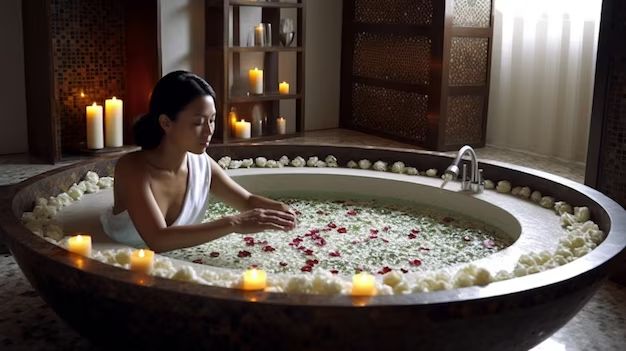When considering getting a hot tub, one of the first questions that comes to mind is what type of surface it can sit on. The surface the hot tub will be placed on is an important factor that impacts installation and long-term durability. There are pros and cons to different surfaces that need careful consideration when deciding where to put your hot tub.
Page Contents
Concrete Pad
A concrete pad is one of the most popular and recommended surfaces for hot tubs. Concrete provides a flat, stable and durable surface that can withstand the weight of a fully loaded hot tub, which can weigh several tons. Here are some of the pros and cons of installing a hot tub on a concrete pad:
Pros
- Very durable and able to withstand heavy weight
- Does not shift or settle like other surfaces
- Smooth, flat surface simplifies installation
- Does not rot or degrade like wood
- Low maintenance
Cons
- More expensive than other surfaces
- Proper drainage required to prevent standing water
- Cracks may develop over time and require repair
- Hard, inflexible surface that can crack if hot tub moves
- Cooler surface temperature than wood
Overall, a concrete pad is an ideal choice for most hot tub installations due to its strength and stability. It may cost more upfront but requires little long-term maintenance. Proper drainage and a gravel base should be installed under the concrete to prevent cracking and sinking.
Wood Deck
Wood decks are another very common surface used for hot tubs. The natural look and feel of wood complements most backyard hot tubs. There are several factors to weigh when considering a wood deck:
Pros
- Softer, warmer feel underfoot than concrete
- Beautiful natural look
- Less expensive than poured concrete pad
- Easier to build and alter as needed
Cons
- Not as stable or durable as concrete over time
- Can rot, splinter and degrade without proper maintenance
- Not as smooth and flat as concrete
- May require additional support for heavy hot tub weight
- Wood can become slippery when wet
Wood decks need to be built to stringent standards to support a hot tub. Proper joist spacing, girder support beams and high-quality decking materials are required. Pressure-treated lumber and composite decking will withstand moisture better than natural wood. Routine maintenance is required on wood decks.
Paver Patio
Interlocking paver stones make an attractive surface for hot tubs on patios. Pavers come in a variety of shapes, colors, textures and patterns to complement your backyard design. considerations for paver patios include:
Pros
- Aesthetically pleasing, versatile designs
- Permeable surface allows drainage
- Easy DIY installation option
- Can match existing hardscapes and landscapes
- Less expensive than poured concrete
Cons
- Not as stable as concrete, can shift and settle
- Sand/gravel sub-base required for drainage
- May require reinforcing with concrete pad for heavy hot tubs
- Irregular surface not ideal for hot tub installation
- Can become uneven or weedy over time
Paver stones look great but may not offer enough structural support for large hot tubs without an underlying concrete pad for reinforcement. Proper base preparation is crucial for stability and drainage.
Gravel
Gravel offers a simple, inexpensive surface option for hot tubs. Key considerations with a gravel base include:
Pros
- Very affordable
- Easy to grade and work with
- Natural drainage
- Can be used as sub-base for other surfaces
Cons
- Not stable or uniform enough for hot tub support
- Can shift, scatter and sink unevenly
- Sharp edges can damage hot tub shell
- Can spread into grass or plantings
- Drainage can wash gravel away over time
Gravel works well as a sub-base layer but should not be used alone for hot tub support. It must be contained by edging and combined with a top surface layer of wood, pavers or concrete.
Dirt/Grass
Simply placing a hot tub directly on grass or dirt is not recommended. Here are some key problems with dirt and grass:
- Not solid enough to support weight
- Will sink, shift and settle unevenly
- Erosion and drainage issues
- No protection from ground moisture
- Grass and weeds will grow up through cracks
- Mud will splash up on the hot tub from users’ feet
A natural dirt or grass surface cannot properly support a hot tub. A solid foundation like concrete, gravel or pavers must be installed to provide a stable base.
Installation Requirements
Properly installing a hot tub foundation is just as important as selecting the right surface. Here are key requirements to ensure proper hot tub installation:
- Reinforced concrete pad at least 4 inches thick
- Level surface free of dips or bumps
- Proper drainage system and/or permeable sub-surface
- Clear area 5 feet around hot tub for access and maintenance
- Do not install directly on bare ground or grass
- Surface must be greater than the dimensions of the hot tub
- Stable enough to withstand weight when fully loaded
- Meet any local building codes or permit requirements
Carefully preparing the hot tub foundation will prevent problems down the road and give your hot tub the support it needs to last for years.
Summary
When selecting the right surface for your hot tub, concrete, wood or pavers are the best options. Each has pros and cons to weigh carefully. A proper subsurface for drainage and preventing settling is also key. Avoid gravel, dirt or grass alone as they will not properly support a hot tub. With careful planning and preparation, you can create the perfect foundation for your hot tub to enjoy for years to come.
